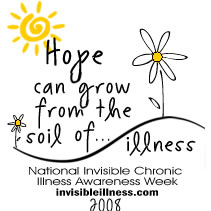For National Invisible Chronic Illness Awareness Week this week, its sponsors at Rest Ministries and volunteers have created and compiled a tremendous array of resources for those of us with invisible illnesses.
- Presentations from the virtual conference cover topics from relationships to work to identity. Several presentations remain this week, but all of them are archived for you to listen to whenever you need a boost.
- The website has a large collection of articles on a wide range of issues that folks with invisible illnesses — and those who love us — confront every day, like the difficulties of explaining an illness to friends, how to respond when someone is insensitive, and how to help people with invisible illness.
- The statistics and stories section has some shocking information about chronic illness. Like that nearly half of Americans have a chronic illness, 96% of which are invisible, and the divorce rate among the chronically ill is higher than 75%.
Poke around the site for a bit. I bet you’ll learn something new that will help living with an invisible illness a little easier.






 In addition to living with the symptoms of headache disorders or migraine, having an illness others can’t see can be extraordinarily frustrating. Rest Ministries is raising awareness of life with invisible illness this week during National Invisible Chronic Illness Awareness Week. Check out the following press release for information on the week.
In addition to living with the symptoms of headache disorders or migraine, having an illness others can’t see can be extraordinarily frustrating. Rest Ministries is raising awareness of life with invisible illness this week during National Invisible Chronic Illness Awareness Week. Check out the following press release for information on the week.